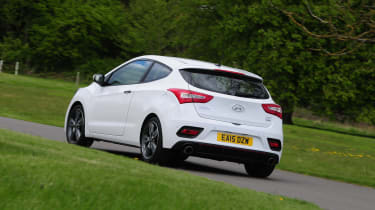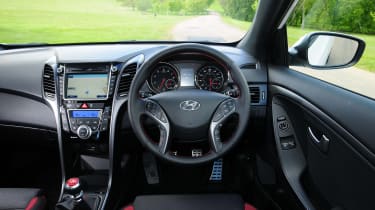Hyundai i30 review (2011-2016)
Sharp looks, a classy interior and reasonable dynamics mean the Hyundai i30 is a strong contender in the hatchback class

Hyundai has come a long way since its days as a bargain basement brand. Today, it produces seriously competitive cars that can rival the best Europe has to offer, and the i30 hatch was one of the first models to achieve this. The second-generation model delivers a winning blend of space, running costs, equipment and value.
The i30 is available as a three or five-door hatchback, although the former is now only offered with the rapid i30 Turbo warm hatch. If you need more space, then you can opt for the more practical i30 Tourer estate.
The Hyundai i30 rivals hatchbacks like the Ford Focus, Mazda 3, Volkswagen Golf and Kia Cee’d. It comes with a range of petrol and diesel engines that are geared towards economy rather than power, while the chassis is safe and secure rather than exciting.
Trim levels range from basic S, through mid-range SE and SE Nav to top-spec Premium. Entry-level cars get a 1.4-litre petrol engine, although we’d recommend the 1.6 CRDi diesel or 1.6 GDi petrol for their improved performance and motorway refinement.
All cars get Bluetooth, keyless entry and tyre pressure monitoring, with top-of-the-range Premium cars boasting 17-inch alloys, automatic lights and wipers, sat-nav and leather effect seats.
Used - available now
Interior quality is a step ahead of older Hyundais, although it's starting to look a little dated compared to the latest hatchbacks, while all i30s come with the reassurance of Hyundai's five-year, unlimited mileage warranty.
Engines, performance and drive
From behind the wheel the Hyundai i30 is comfortable, the engines are relatively smooth and it’s easy to drive, if not particularly exciting. There’s a decent amount of grip, and while there’s some body roll in corners, it’s largely kept in check.
Active versions and above get the brand’s new Flex Steer system, which allows drivers to choose from Comfort, Normal and Sport settings by pressing a button on the multifunction steering wheel. Flex Steer alters the weighting of the steering to suit road conditions and your mood. However, you’ll struggle to notice the difference in each mode, and even Sport lacks the feedback you get in a Ford Focus or VW Golf.
• Best hatchbacks on sale right now
The i30's ride quality is good, although it can’t iron out imperfections as well as a Golf. It thumps into potholes at low speed, while motorway expansion joints resonate through the cabin.
There's a choice of 1.4-litre and 1.6-litre petrol and diesel engines. The pick of the range is the 1.6 CRDi diesel, as it’s a smooth and punchy performer in both 108bhp and 126bhp guises. All models get a slick six-speed manual gearbox, while a six-speed automatic is available as an option.
There’s a 184bhp i30 Turbo for performance fans, but it’s more of a warm hatch than a hot one. It’s good to drive, with plenty of grip and very little body roll, but if you want strong performance we’d recommend stepping up to a Ford Focus ST or VW Golf GTI.
MPG, CO2 and Running Costs
The most efficient i30 is the 1.6 CRDi Blue Drive. The 108bhp model promises to return a city car-rivalling fuel consumption figure of 78.5mpg and emits only 94g/km of CO2.
All versions should be quite cheap to run, as even the entry-level 1.4-litre 98bhp petrol engine manages to return average economy of more than 47mpg with CO2 emissions of 138g/km.
Every i30 comes with a decent haul of equipment, as well as Hyundai’s excellent five-year warranty and free breakdown assistance package. Low prices means it will cost you less to buy than many of its more premium rivals, too.
One of the i30’s biggest problems, though, are its poor residual values, with most versions only holding onto around 39 per cent of their value after three years. But fixed-price servicing over three years of around £350 for the petrol cars (around £450 for the diesels) is competitive, and that standard five-year warranty is a big plus.
Interior, design and technology
Today, even mainstream five-door hatchbacks have to make an impact, and the Hyundai i30 is arguably one of the better-looking models on sale. All cars get bright LED daytime running lights, a hexagonal grille and sculpted lines that flow along the body to the high-set tail. As a result, it’s a lot more cohesive and attractive than the Nissan Pulsar, for example.
The standard three-door model was dropped in 2015 due to poor sales, but you can still buy an i30 Turbo three door, if practicality isn’t a top priority.
On the inside, build quality is impressive, but there are still some hard plastics and shiny surfaces. It can’t quite rival the VW Golf or Ford Focus for upmarket appeal, but it’s more than a match for the Renault Megane or Toyota Auris.
There are four trim levels to choose from. Early versions had Classic, Style and Style Nav trims, but they were replaced by S, SE, SE Nav and Premium models in 2015.
Basic S models are well equipped, but we’d step up to the SE, which adds 16-inch alloy wheels, cruise control, leather trim for the steering wheel and gearknob, and rear parking sensors. Premium cars get bigger wheels, auto lights and wipers, as well as dual zone climate, heated front seats and leather-effect tirm.
Inside, the dashboard centre console design is stylish, with its two-tone silver trim and quality materials. Yet while the switchgear has a quality feel, the laid-back dashboard means the driver has to stretch forward to reach some of the buttons on the left of the centre stack.
Practicality, comfort and boot space
The i30's 378-litre boot rises to 1,316 litres with the back seats folded - that's just two litres less than the VW Golf and 62 litres more than the Focus hatch. The boot is a good shape on both the five and three-door models – although it’s worth noting that only the i30 Turbo is available as a sleeker three-door from 2015 onwards.
There’s plenty of room up front for the driver and passenger, while the rear bench will easily accommodate three adults. This is helped by the fact that the middle seat benefits from a flat floor - which frees up space in the footwells. However, the small rear windows and black fabrics and plastic make it feel claustrophobic.
There’s also plenty of cabin storage, with all models getting deep door bins, an air-conditioned glovebox and useful lidded cubby between the front seats.
Reliability and Safety
Hyundai is gaining a reputation for making reliable cars, and its five-year warranty helps. It goes one better than Toyota’s 100,000-mile package by not having a mileage limit, and five years’ breakdown cover is also included.
The Driver Power 2016 survey saw Hyundai fall to 30th out of 32 manufacturers - a nine-place fall on its 2015 result, which amounts to a 23-place fall in recent years. The i30 finished in a slightly disappointing 114th out of 150 cars.
Euro NCAP awarded the i30 a five-star crash test rating in 2012, and the hatch features six airbags, stability control, hill-start assist and emergency stop signalling as part of its list of standard safety kit.












